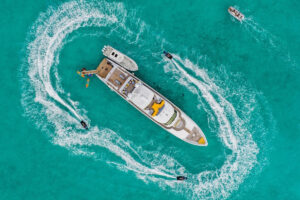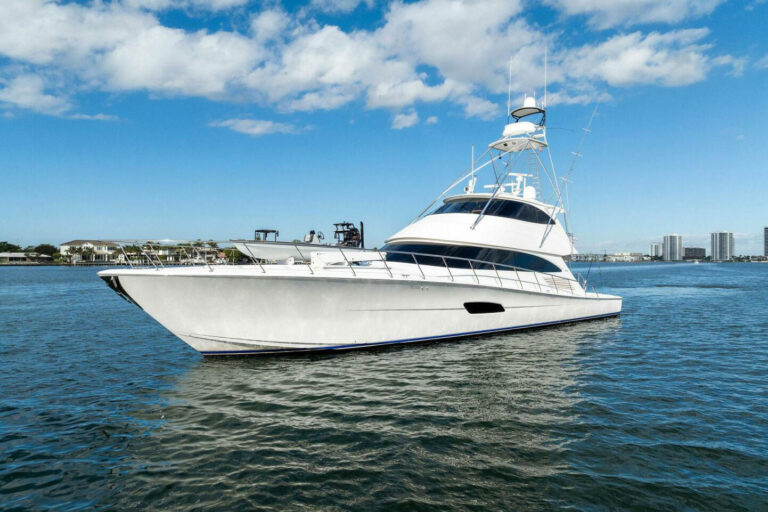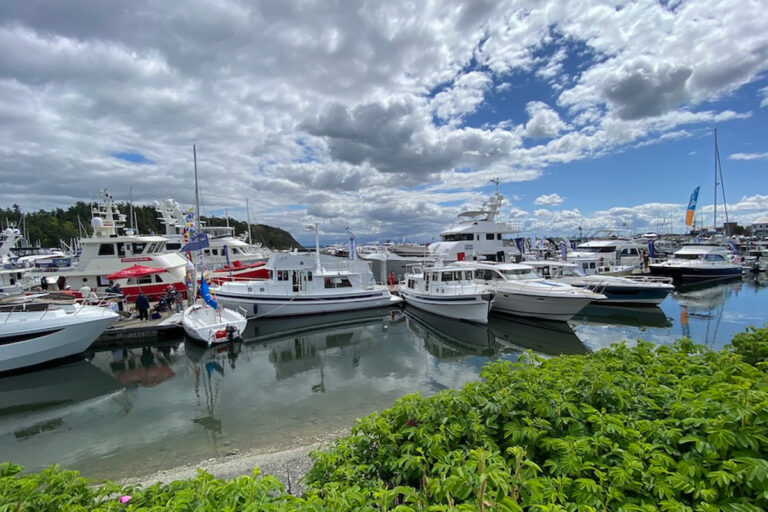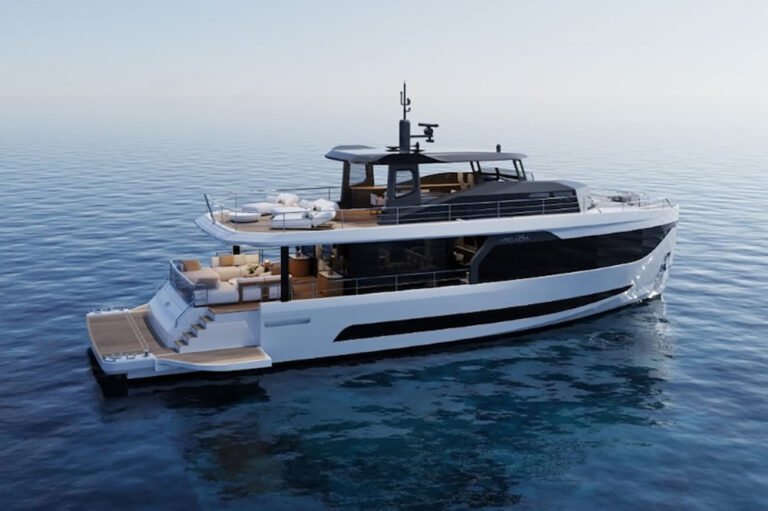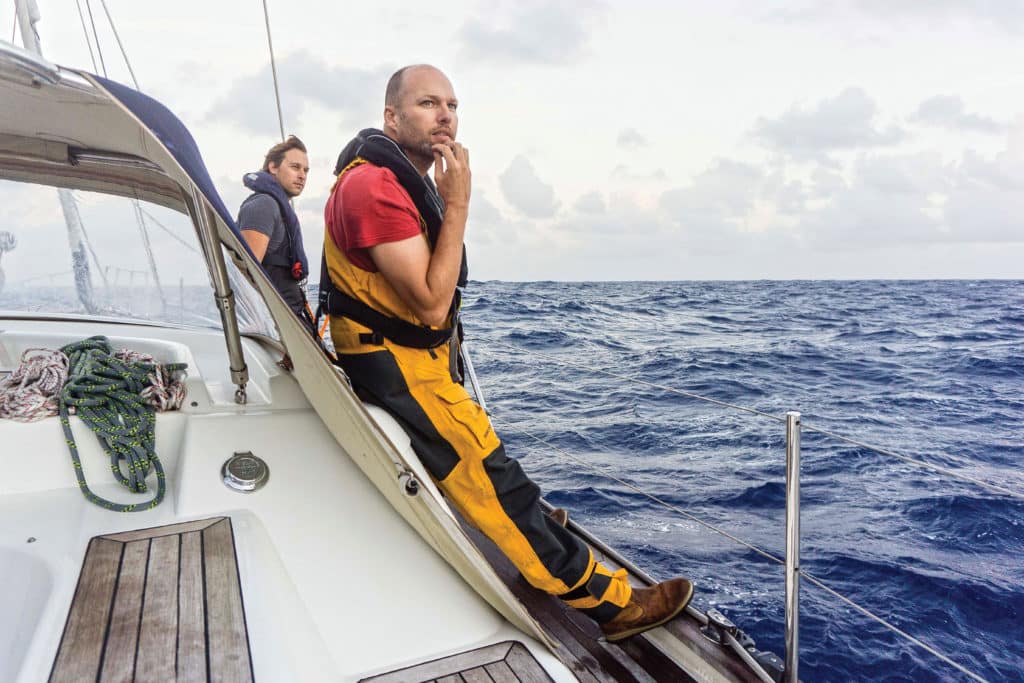
Capt. Andrew Kaiser was hundreds of miles offshore, hoping the latest plan would work. Seas were 5 to 10 feet with an occasional 15-footer, and the 600-foot cargo ship was in position, attempting to create a breakwater. Kaiser tried to bring his 67-foot Discovery Tilly Mint alongside Dove II, a 56-foot sloop that had lost her rudder two days earlier.
But as Tilly Mint neared, the yachts both rolled. Their masts nearly collided. Kaiser backed off, watching the captain of the 30,000-ton freighter also work to maintain control, close enough to crush them all.
There was no more denying it: The family had to climb into their life raft and set adrift on faith that Tilly Mint would save them. Everything else had been tried and failed. “It’s a hard thing to ask a family to do,” Kaiser says.
The mother, her 71-year-old stepfather and her two children climbed in. They left the father behind. The kids were just 7 and 9 years old.
12:10 on December 20
The summer charter season had been outstanding. Tilly Mint spent it in Norway, cruising through the foggy, majestic fjords that span the Scandinavian coastline, keeping a lookout for whales and cruising as far north as the Arctic Circle. The crew had seen parts of the planet, and experienced a level of grandeur, that most other human beings can only imagine.
But summer had turned to winter, and the Caribbean season beckoned. The crew had to get Tilly Mint over to St. Vincent and the Grenadines in the southern Caribbean, where they were scheduled to pick up charter clients on December 26 for a New Year’s holiday aboard.
Prepping for the crossing felt routine to Kaiser and his crew. Transatlantics were standard stuff for Tilly Mint, a 2009 build that regularly chases the seasonal sun. Kaiser and his wife, Arwyn, who serves as chef and mate, had crossed the Atlantic a half-dozen times on Tilly Mint and once more aboard a previous yacht. They had heard of other boats getting into trouble out there — search parties, sinkings, nothing to take lightly — but they had always crossed without incident, never finding themselves in trouble or in a position close enough to assist any of the boats that did encounter misfortune.
The Kaisers, along with crew members Dan Fox, Catherine Marks and Will Marks, were in a sort of relaxed state of making haste. After doing maintenance in England, weather delays held up their start date. They were confident in the undertaking, but they also felt mounting pressure. They were looking at about 4,600 miles ahead, as the crow flies, with a hard deadline that would have charter clients standing on the dock, waiting for them with luggage and vacation dreams, whether Mother Nature cooperated or not.
“I severely underestimated how difficult this was going to be. You learn about this in captain’s training, but once you’re there, emotions enter the picture. You suddenly realize that there are serious consequences at stake, a human element — this is absolutely frightening.”
Capt. Andrew Kaiser
Advertisement
So they pushed it. They stopped for just three hours to fill the yacht’s tanks and reprovision their stores in the Canary Islands before setting a course for the Atlantic’s other side.
“It was a big, stressful moment, as it is for many charter yachts,” Kaiser says. “You have this whole ocean to cross and a million things that can happen, and you have to make a timeline on the other end.” Thankfully, Mother Nature took a shine to them, and they got to experience the thrill that comes with another of life’s great cruising pleasures: hour after hour of the yacht, the wind and the sea all working together as one, with land nowhere in sight. It was Tilly Mint and the Atlantic, in perfect harmony.
“Finally, it all starts to turn our way, the wind fills in, we’re flying, we have both headsails pulled out, we’re heading downwind, and we finally felt like our luck had turned,” Kaiser says. “We were going so fast that we might even have an extra day when we got there to clean the boat up and rest a little before the charter, maybe have a beer.”
They were about three days out from their Caribbean landing, surfing down waves at speeds that even they couldn’t believe — they took one at 19.9 knots, Kaiser says, still excited to describe the feeling a number of weeks later. The distance they were covering was impressive too: day after day of 220- to 230-mile passages. It was the fastest they had ever covered that much water on a transatlantic crossing.
“Everyone was in good spirits, and lunch was just about to come up, and the crew were hovering around, waiting like they always do,” Kaiser says. “And all of the sudden, the satellite phone rings.”
It was 12:10 on December 20, about 600 miles east of the Caribbean archipelago.
“We all stared at the phone,” he says. “It was the first time this phone had rung in three years. We weren’t expecting to take a phone call in the middle of the Atlantic.”
Aboard Dove II
The Coombes family had been enjoying their sail too. Dolphins had put on a show in their wake, followed by a few whales, as they made way from Portugal to the Canary Islands. According to the family’s blog, the kids had overcome some initial seasickness, the tuna fishing had turned out to be great, and Dove II was making solid time, covering some 160 miles at 11 knots. They finished their first week out of the Canaries unscathed, but the mom worried as many mothers do.
She wrote on the family’s blog: “This next week is the one I’m dreading, the middle one, the one when you’ve already done ages but you’re still not halfway, the one where you’re in the middle of the ocean as far from anything as possible.”
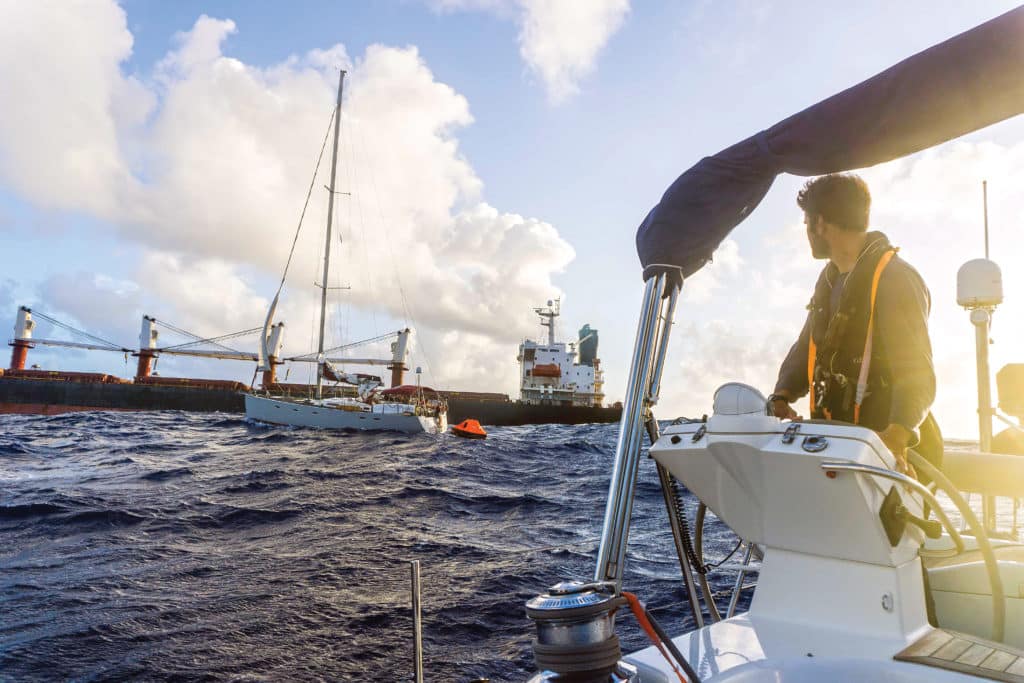
As things turned out, her premonition was off by about 24 hours. Day 15 was when Dove II somehow lost her rudder, in 20- to 30-knot winds. The yacht rolled hard. The swell repeatedly knocked it down. After about an hour of enduring the pounding, the mom pressed the preprogrammed button on the satellite phone. Falmouth Coast Guard answered and began to coordinate with the Coast Guard out of Martinique, on the other side of the ocean.
About four hours later, the 600-foot cargo ship Newseas Jade arrived. Plan A was for the ship to come alongside Dove II and drop some lines for the family to climb up. At about 2 in the morning. In the pitch-black darkness. In roiling seas.
The kids started screaming as the ship bore down, firing its lines toward the family. The mom, on the family’s blog, described the moment as “like having fireworks shot at you.”
They feared the massive ship would crush them. From their perspective, they were sitting ducks in the looming shadow of a leviathan.
What, they wondered, was Plan B?
Beating Their Way Back
When the shock wore off that their sat phone was ringing in the middle of nowhere, Tilly Mint‘s crew answered the call. It was the Falmouth Coast Guard. A cargo ship had picked up Tilly Mint‘s AIS signal, and when the ship did its routine data upload, the Coast Guard realized that Tilly Mint was near Dove II. Even in hindsight, Kaiser is impressed by the technology’s accuracy: “They were only off by about 10 miles on our position when they called.”
The Coast Guard told Kaiser that Dove II was 17 miles to windward. The cargo ship had moved to Plan B after coming close alongside the sailing yacht nearly a half-dozen times; now they were talking about the family getting into an inflatable life raft that would sit alongside the mammoth ship in the churning seas — a thought that terrified the family to the point that the mom got back on the sat phone and begged the Coast Guard to make it all stop.
And so, the Tilly Mint crew was asked if they would be willing to render assistance.
“Of course, this isn’t really a question — of course the answer is yes, no matter what,” Kaiser says.
Kaiser spun Tilly Mint‘s wheel and headed upwind.
“It was like a different world,” he says. “It was a lot for the boat. We definitely wouldn’t have pushed the boat that hard if it wasn’t an emergency.”
“You are the one on scene, not the coast guard. They did nothing wrong; they are authorities. They save people’s lives for a living. I’m a charter yacht captain. But if we’d done what they said, it would’ve been really bad. You have to make your own calls out there after consideration.”
Capt. Andrew Kaiser
For the next 10 hours, Tilly Mint made 8 knots at best, with spray coming over the bow the whole time.
“We were on our side with the motor at full rpm, going into it the best we could,” he says. “It ended up being a marathon.”
The total distance covered to reach Dove II ended up being 88 miles; Tilly Mint sailed about 80 of them, and Dove II drifted the rest of the way.
“When we got there, it was moonless, cloudy, one of those dark and scary nights,” Kaiser says. “There wasn’t much to be seen. We were doing our best to triangulate their drift and our course to intercept them. We could hear the big cargo ship transmitting and relaying a message, so we called them.
“We could see the cargo ship on AIS, and we could see their lights, but the sailboat had just an anchor light on,” he adds. “It looked like a star on the horizon until we were about a half-mile from them. We got right up next to them with our deck lights on, and they saw us and hopefully felt a little relief.”
Everyone decided that attempting Plan C at night was a bad idea.
“After 10 hours of rushing and getting there, and the mission is to get these people aboard and safe, it’s really hard to say, ‘We’re going to wait six more hours for daylight,’” Kaiser says. But that’s what they did, heaving to with a crew member on watch to guard against drift.
“At one point in the night, we sailed back to them and hove to again,” Kaiser says.
By morning, the Coast Guard out of Martinique had put Tilly Mint in charge, Kaiser says: “Just before sunrise, we all got our heads on straight. We were the small yacht that got to call the big cargo ship and say, ‘This is what we want you to do.'”
Daylight
Plan C for the family — the first attempt by the crew of Tilly Mint — was that Tilly Mint would lower her tender and transfer the family. But the father, Kaiser says, didn’t want to abandon his ship. According to the family’s blog, the journey had been his idea, part of a childhood dream of sailing the world.
“I had to have a conversation with him about it,” Kaiser says. “Everybody was advising him that it was not a good idea. We were going to leave immediately — we had to make our charter. We didn’t want to leave him, but we weren’t going to hang around. He had a really tough call to make.”
For Kaiser, it was not the father’s hesitation, but instead the cargo ship that made him most nervous.
“Something that big with that little control — the captain, bless him, stayed with that family the whole time, and sat there for three days and called them every night to let them know he was there — there’s nothing that crew could have done better, but the fact is that it’s a big, rolling monster with minimal control,” Kaiser says. “They’re the most dangerous thing in the story.”
The Coast Guard notified Tilly Mint that it wanted the cargo ship to create a breakwater, hoping an artificial lee would allow the family to get off Dove II safely. Kaiser spoke with the family about that plan, and about what Plan D would be if it didn’t work.
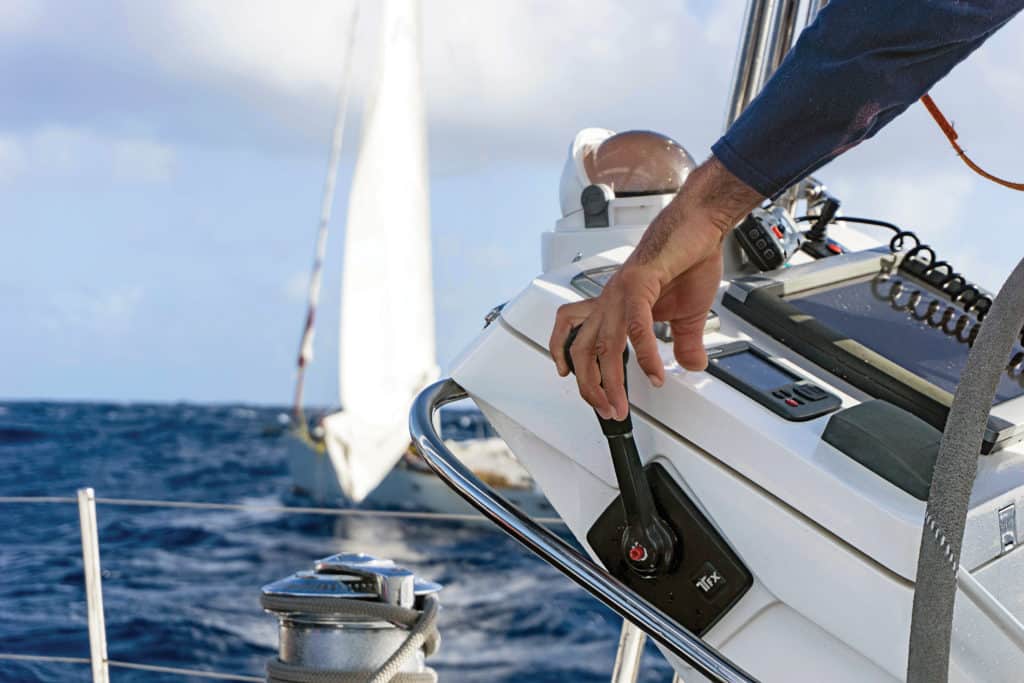
“We were nervous, we knew they were nervous, so we wanted to act very quickly,” Kaiser says. “If there is a sufficient lee, we will quickly drop our tender and pick you guys up, and then get out of Dodge. But if it doesn’t work, we want you to inflate your life raft and put everybody in it, and we’ll make the transfer then. Initially, we said we would try to collect a line from them so that they would never be in open seas when they cut the line to their boat. We attempted this, but that was a mistake, a bad decision — you lose maneuverability. You’re too close to the other boat.”
Seas were rising. Winds were pounding. The cargo ship moved to windward of the yachts.
“We had a timeline that we had to make this happen before the ship drifted back down on us and killed us and caused damage,” Kaiser says.
But alas, Plan C failed. The cargo ship was able to block the wind, but not the waves.
“We realized the ship was not going to help, so we did not launch our tender,” Kaiser says. “We told them to launch their life raft.”
That’s when the family cut themselves loose from Dove II, with the mother, stepfather and kids adrift, leaving the father behind. He didn’t want Dove II to become a salvage, if she would ever be found at all. He thought he still might be able to save his family’s yacht.
Kaiser brought Tilly Mint alongside the life raft. He couldn’t heave to, to ease the yacht’s rolling, so the crew struck Tilly Mint‘s sails.
“It was scary,” Kaiser says. “We had them alongside our boarding gate on the side. One of my crew members said, ‘Andrew, I think I can grab one of the kids. Should I go for it?’
“The next time we rolled, I saw him almost disappear into the life raft, and he came back up onto our deck with the 7-year-old girl.”
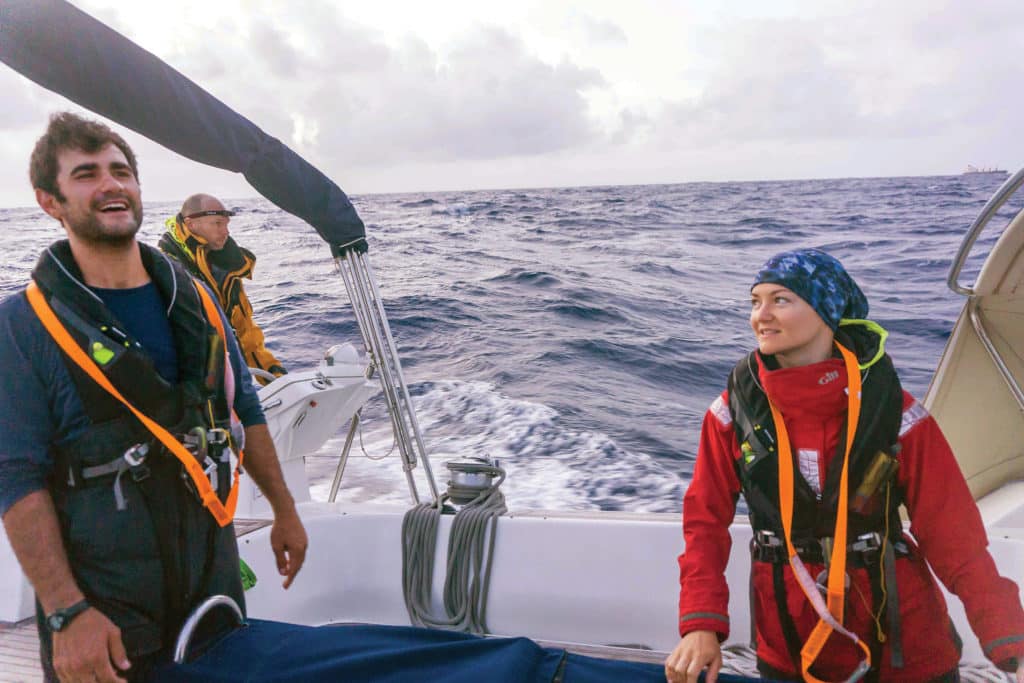
The children, Kaiser says, were by that point courageous and composed. The mother and her stepfather were too.
“The next time we rolled,” Kaiser says, “Will was on our deck. He reached over and pulled the other kid out. They passed us a couple of rucksacks, and then grandpa and mother stepped aboard.” The mom went belowdecks, sat at Tilly Mint’s helm station and called her husband. He had not changed his mind. He told her to set sail without him.
“We sailed past the vessel one last time and waved,” Kaiser says. And then, he pointed the bow toward the Caribbean.
Tilly Mint got about 3 miles downwind, with the crew just about to set the sails, when a call came from the father. In trying to get Dove II sailing again, he had parted his main sheet, which was now in the water and jammed into the prop. He had finally come to realize, he said, that he needed to abandon his ship. Would Tilly Mint go back for him?
“Of course,” Kaiser says, “we did.”
The second recovery went smoothly, with the father repeating the life-raft drill and no cargo ship in the mix. With the whole family aboard, Tilly Mint made way for Martinique, arriving at 21:00 December 23, three days before the start of the Caribbean charter.
“The whole family, even the little kiddos, they helped us with everything, the cleaning and polishing,” Kaiser says. “They were just such good people.”
15:52 January 27
Dove II is presumed afloat at sea. The family, living aboard a boat in Sint Maarten, has had a few hopes raised and then dashed, thinking she’d been sighted but had not. Drift patterns suggest she might be near Anegada in the British Virgin Islands. They are hitching a ride on a catamaran to go take a look.
The son just turned 10. He spent his birthday playing on water toys with his sister and celebrating with cake. His mother and father were both there, in the photos on their blog, as he turned a year older. The boy’s baby photos, like his sister’s, are aboard Dove II. Somewhere, hopefully, still out there.
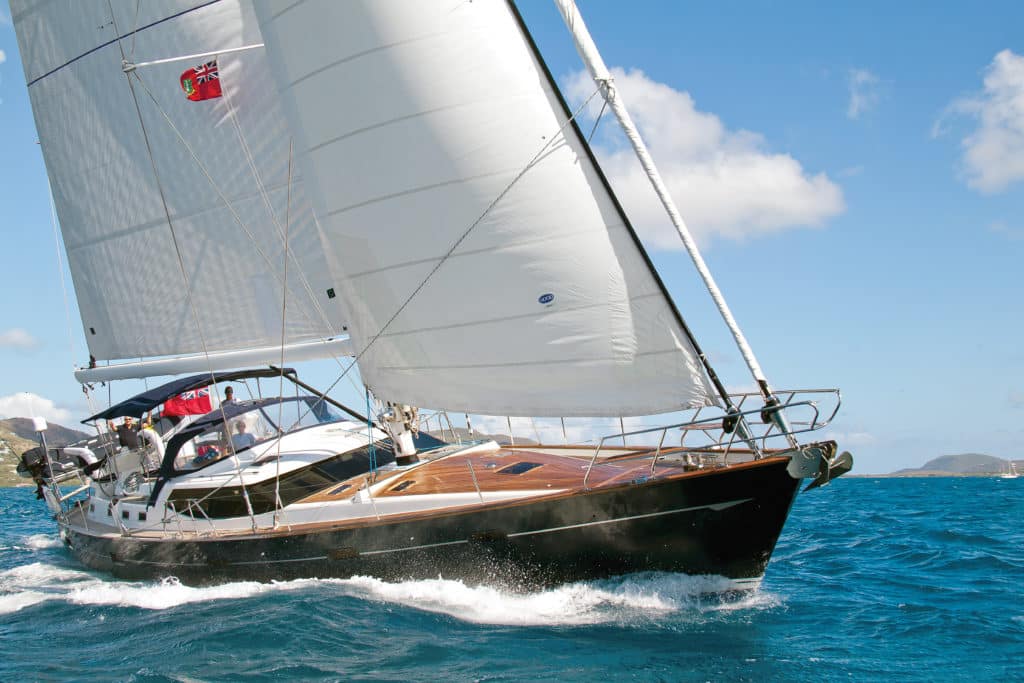
Lessons Learned
When the new year’s charter aboard Tilly Mint ended, Kaiser made a list of lessons learned.
Have multiple ideas: The crew arrived on scene faster than expected, so they used the time to plan. “We all sat around and talked through the best options, not one way to do this, but every way that we could conceivably do it. We didn’t want to become casualties ourselves, and we didn’t want to kill anyone else.”
Adapt: “If what you thought would work is not working, then stop and reassess.”
Beware cargo ships: “It’s a big, moving city that will just pummel your boat. There was only added danger. I mean that with as much respect as possible for the cargo ship and the Coast Guard. It just didn’t do any good for us.”
Be alert: “We’re coming alongside them and trying to get close enough to catch a line because we don’t want them to have to cut themselves loose at sea. This was a mistake. Their boat surfed down two waves consecutively and ended up 100 feet from us, and then the boats rolled toward each other. Even at 100 feet distance, we had a really close call with our masts.”
Maintain space: “Every captain knows that this is dangerous, but how fast those boats closed the distance, and how close those masts came, you need a really large safety buffer. You need much more than you might think.”

